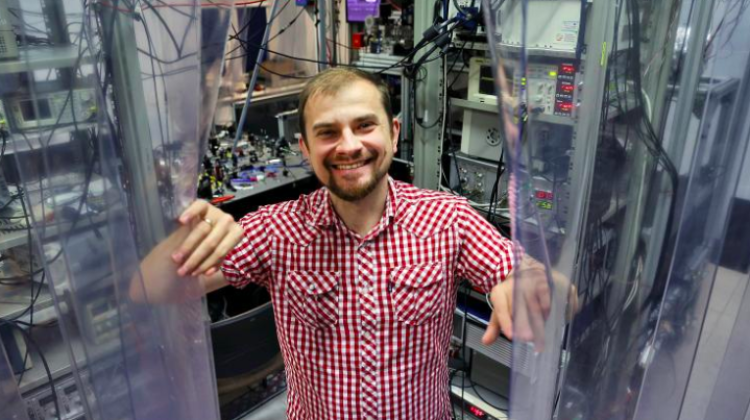Quantum, frozen LEGO bricks
 Photo by Andrzej Romański
Photo by Andrzej Romański
How to build molecules from rubidium and strontium atoms at temperatures very, very close to absolute zero? The idea comes from an international team of scientists, including Dr. Piotr Żuchowski from the Nicolaus Copernicus University.
The results have been published in the prestigious journal Nature Physics. The representatives of the Nicolaus Copernicus University informed about the research in a release.
The ability to deliver ultracold molecules with different properties on request is a great dream of physicists. A gas composed of such ultracold molecules can have many innovative applications in basic research, such as testing the limits of basic physics or studying chemical reactions in exotic, strictly controlled conditions. The system of many ultracold molecules can also be used to study the quantum mechanics of many bodies, which is crucial in the design of new materials.
Cooling matter to such low temperatures is not an easy task. At room temperature, atoms and molecules move at speeds of hundreds of meters per second, they vibrate and rotate. Over the past 30 years, physicists have developed techniques to cool atoms, in particular laser cooling, during which a specially tuned laser slows atoms down. However, molecules - structures composed of many atoms - are much more difficult to cool down to such a low temperature, because they also vibrate and rotate.
That is why in some studies, instead of cooling molecules, physicists first cool atoms - the bricks of which molecules are built. And then they use these "frozen" bricks and try to assemble a molecule. The most difficult challenge is to find conditions that allow atoms to attract and connect into molecules, like matching bricks.
A helpful phenomenon is the Feshbach resonance, which consists in the possibility of transition from the state of chemically unrelated atoms to the state of a bound molecule.
Until now, researchers were only able to produce molecules of two alkali metal atoms that have one unpaired electron and therefore can form highly bound molecules. A group of scientists from the University of Amsterdam, the Nicolaus Copernicus University in Toruń and the University of Durham in the UK made a leap towards the creation of a new type of ultracold molecules. They discovered Feshbach resonance in a system consisting of rubidium (an alkali atom) and a strontium atom, which has all its electrons paired (it is an atom from the second group of the periodic table of elements).
Already eight years earlier, Piotr Żuchowski and Jeremy Hutson in theoretical studies predicted a new type of weak resonant coupling that could cause Feshbach resonances. Using molecular spectroscopy, the experimental group was able to complement and confirm these predictions. Ultimately, this resonance is the appropriate mechanism for constructing ultracold exotic RbSr molecules.
These molecules have radically different properties compared to molecules that have been created so far. "What is particularly attractive about the RbSr molecules is that they react to both magnetic field and electric field. Thanks to this, we have two independent ways to manipulate the molecule using external fields: electric and magnetic" - explains Dr. Piotr Żuchowski.
There are several reasons why physicists are interested in ultracold molecules of a new type. First of all, the fact that they are ultracold, or immobile, allows to learn more about them. Similarly with molecules, by studying them with photons (with light) we can expose them to the action of photons for a much longer period when they are immobile. This opens the way to a very precise examination of the properties of these molecules, which in turn may help in the discovery of a new physics that goes beyond the modern standard model.
Secondly, ultracold molecules can be prepared precisely in selected quantum states that can be used in quantum controlled chemistry. It is possible to run (and study) their chemical reactions in a strictly controlled way using the electric and magnetic field as the "knobs" that control the reaction.
Thirdly, ultracold molecules in several or multi-component gases can be used to better understand the behaviour of many quantum particle systems. At a temperature of one millionth Kelvin, the nature of these molecules becomes very apparent. As a result, new quantum phenomena can be revealed, ones that are difficult or impossible to predict using even the best supercomputers. According to Prof. F. Schreck, a better understanding of the collective behaviour of quantum multi-particle systems, for example ultracold molecules in quantum gas or electrons in metal, can open the door to designing new materials with fascinating properties.
The results of this research greatly expand the available tools for building new ultracold molecules, like from LEGO bricks. The experimental group leader Prof. Florian Schreck from the University of Amsterdam hopes that it will soon be possible to obtain ultra-cold, dense gas of stable molecules composed of rubidium and strontium. Given the number of potential applications that such a gas would have, Schreck and his group are very excited about the possible new research directions.
PAP - Science in Poland
lt/ ekr/ KAP/
tr. RL
Przed dodaniem komentarza prosimy o zapoznanie z Regulaminem forum serwisu Nauka w Polsce.














